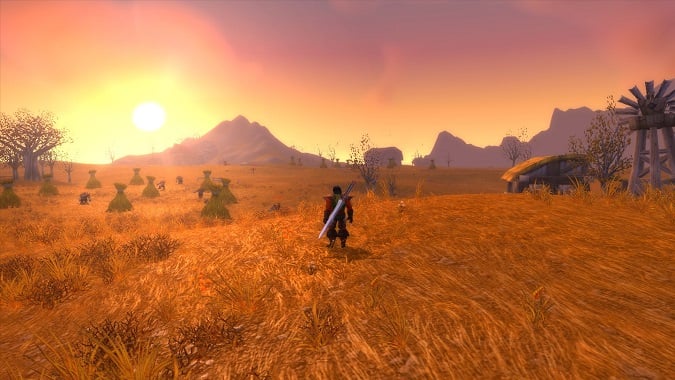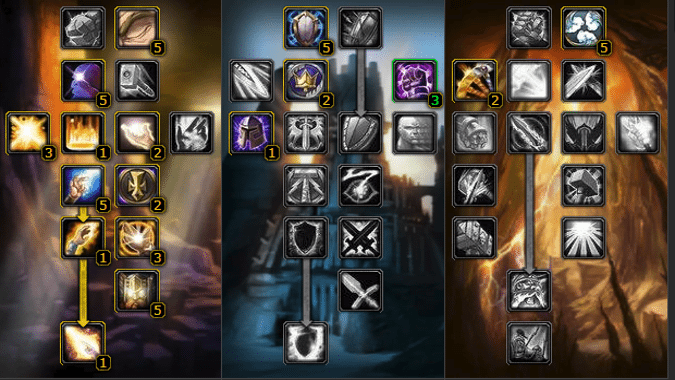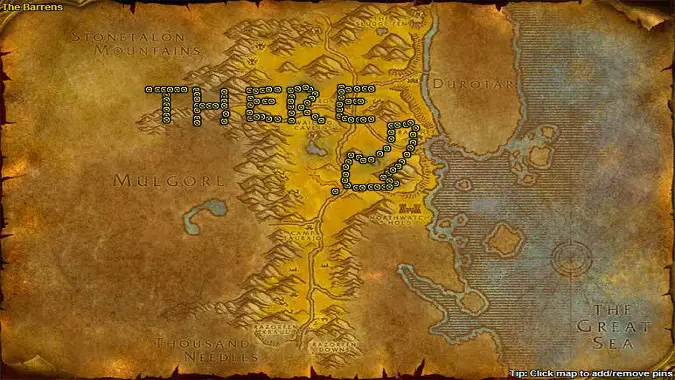WoW Archivist: 10 tips to survive the Classic demo

BlizzCon is so close now! With it, attendees and Virtual Ticket holders will have (limited) access to the World of Warcraft Classic demo. It’ll take place from levels 15-19 in the iconic zones of Westfall and the Barrens. For those who played Classic back in 2004, it’ll be nostalgia overload. For those who did not… it might be quite a shock.
MMO-Champion recently datamined a list of the original WoW loading screen tips from the demo. It’s a fun little jaunt back in time to an era where people didn’t know how to tab target or what the colors of item names meant. But most of this stuff is second nature by now.
What do you really need to know to survive the WoW Classic demo? WoW Archivist has your back.
1. Buy food and water
No, really. If you want to stay alive, you’re going to need it out there. Mobs in general hit much harder in Classic. It wasn’t like today where you can pull a whole area and burst AOE them without worry. Fighting two mobs at once was concerning. It was generally better to run than to fight three. Raid gear helped later on, obviously, but in quest gear you had to be very careful as a solo player.
Players also ran out of mana much faster in Classic. DPS classes especially were vulnerable to OOM’ing since they didn’t get much help with mana issues like healers did. During boss fights, chain-chugging mana potions was the norm for any magic-based class (and yes, that included Hunters). You won’t have to worry about that while questing, but you will need to take a break to eat and drink between pulls. Food will save your life when you’re in a dangerous area and you come away from a fight with low health. Health and mana potions are also a good idea for emergencies.
Caster classes should make sure they have a wand equipped. You’ll need it if you run out of mana during a fight. It’s also a good idea to finish off mobs by wanding. This allows your mana regen to kick in faster so you have a little more mana for the next pull. (The reason for this is complicated, but it works.)
Warriors and Rogues should use their ranged weapons to pull mobs to them instead of charging forward. The safest thing is to set up in a spot where no mobs patrol or spawn and fight enemies there.

2. Group up
It’s harder to quest solo — not just because of the difficulty, but because of the old tagging rules. A tag by anyone outside your party would make the mob gray to you, giving you no experience or quest credit. If you see someone of your faction working on the same quest, invite them to join you.
Having trouble with a quest? Ask for help in zone chat — if you dare.
This is how a lot of friendships formed in early WoW: chance encounters in random leveling zones. I still have real-life and online friends that I met this way.
3. In a group, your role is fluid
This is a point that will become more important in the real Classic game when dungeons and raids are available, but it still applies to group questing. Sometimes you’ll have to step outside your role to succeed. Blizzard designed the original classes with the tools to do so.
Hybrids were more hybrid-y back then. A Shaman could throw out a healing spell to keep people alive, or they could pull aggro with Rockbiter Weapon to help off-tank a mob when your group gets too many.
Pure DPS still had ways to help. A Hunter could grab aggro with Distracting Shot, kite the mob away, and then Feign Death in order to buy the group more time. (You won’t get Feign Death until level 30, but my point stands.)

4. Spend points in other talent trees
Even if you’re hellbent on playing Combat or Affliction, the other trees still have valuable talents. Many specs in Classic went with 31/20 or 30/21 builds. Specs weren’t quite so specialized. In early leveling especially, it made sense to pick the best talents in those early rows regardless of the spec you “identified” as. Keep in mind that the Classic trees were designed to have talents that synergized with other specs in their early tiers, such as Furor in Druid’s Restoration tree or Deflection in Retribution.
You don’t need to put a certain amount of points into one tree before you can add them to the other, like you did in Cataclysm. The only general restriction is that you have to put five points into one row in a given tree before you can put points into the next row. But you don’t have to! You can put all your points into the first row if that’s better for questing. The other restriction is the arrows that tell you which talents are required to unlock other talents, but those come into play more often at higher levels.
In the demo, you’ll have a maximum of ten points to spend. This is a little unfortunate, because most of the exciting early talents, such as Enhancement’s Two-Handed Axes and Maces or Balance’s Omen of Clarity, required eleven points. It’s definitely a tease.
5. Read the quest text
Your quest objectives aren’t marked on the map in Classic. You have to figure out where to go. Now, you could keep Alt+Tabbing to a website with the information or you could just take a moment to read the quest. I know, I know, it sounds ridiculous. But just try it and see how it feels. Very often, those quest givers gave pretty specific directions. You’d be surprised.

6. Explore the zone
We’re so used to following breadcrumb after breadcrumb as we level. Quests from The Burning Crusade onward took us on guided tours of each zone. In Classic — where the very idea of leveling primarily through quests in an MMO was brand new — quests weren’t like that. You had to go off on your own to uncharted areas in order to find new quests. Sometimes, it was just a matter of discovering the next town. Sometimes, the quests were hidden in far-flung corners of the map in dangerous places.
Outside of “cheating” with a website or — yes they were a thing back in the day — an actual printed guidebook, you had to just go out there and find stuff. Of course, you can always ask your zone chat friends, too.
Just be ready to do a lot of running, because mounts weren’t available until level 40. You know, if you could actually afford one, plus the fee to learn the riding skill.
7. Loot everything, sell frequently
Gold was hard to come by, and inventory space was limited. You always wanted to sell everything you could loot, whether on the Auction House or at an NPC. Because bags were expensive, you often had to go without a lot of bag space early in your WoW career. That meant frequent visits to vendors to unlock all your grey items. Half the time while leveling in Classic, I used my Hearthstone not to cash in quests but to liquidate all the junk in my bags.

8. Visit your class trainer
But gold doesn’t matter, you say — it’s just a demo! Not so, if you want to experience everything your class can do. Spells won’t be learned automatically. You’ll have to shell out hard-earned cash to your class trainer so they’ll share their secrets. This system was far more realistic than that of today, where your character has a sudden flash of inspiration to learn a new spell upon leveling.
9. Be careful switching weapons
Weapon skill was a thing back then — a pretty major thing. If you get a sweet new axe but you haven’t ever used an axe before, prepare for a little bit of a grind as you level up your character’s skill with that weapon type. The only way to do it safely — outside of some very specific cheats — was to find easier enemies and flail away until you had the skill to actually hit them.
Speaking of, even with maxed-out skill, you’re still going to miss or get parried by enemies. You’ll have to equip gear with % to hit in order to hit the enemy every time, but good luck finding that at level 19…
Some players made it a habit to equip different weapon types while leveling, even if they weren’t the best option available, to keep all of their weapon skills up to date. Dual-wielding characters could also put their low-skill weapon as their offhand until they got the skill high enough to use it in their main hand.

10. Your gear will be bad
Itemization in Classic was notoriously awful. Agility gear with Spirit? Strength gear with Intellect? You’ll see that in spades, even as quest rewards. Blizzard didn’t want to limit a spec to just one main stat, so there was plenty of “extreme hybrid” gear out there. It was never even close to optimal, but it did help classes to play in those more fluid roles that I mentioned, if the player desired. Even tier gear from raids had a mix of stats that would be considered heretical today.
At low levels, you’ll only see main stats on gear for the most part. Hit and Crit were mostly for higher level items.
However, primary stats did way more in Classic. Strength gave melee attack power and allowed you to block more damage. Intellect gave you spell Crit along with a bigger mana pool. Agility gave Crit, Armor, Dodge, and both ranged and melee Attack Power. This is partly why Agility gear was often optimal for warriors and other “Strength-based” classes up through Wrath of the Lich King. Spirit regenerated health as well as mana out of combat, so it actually did help you to speed up your questing. Some players opted for a strong mix of spirit gear while leveling for just this purpose.
Bonus tip: Be glad you can’t go visit Sylvanas in this demo. She was having a tough time back then…
Please consider supporting our Patreon!
Join the Discussion
Blizzard Watch is a safe space for all readers. By leaving comments on this site you agree to follow our commenting and community guidelines.
 @QuestVendor
@QuestVendor




